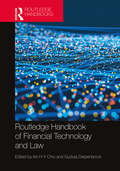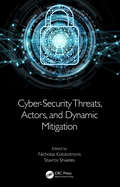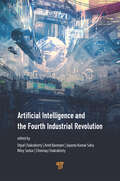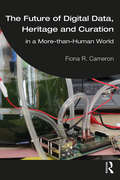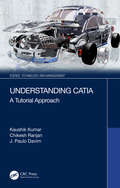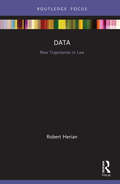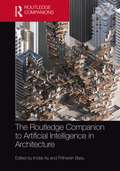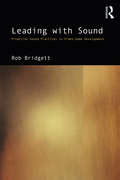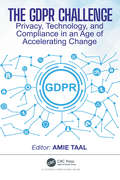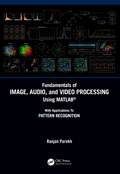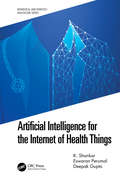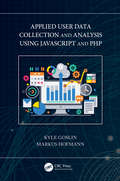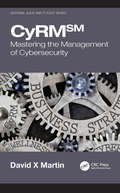- Table View
- List View
Routledge Handbook of Financial Technology and Law (Routledge Handbooks in Law)
by Iris H-Y Chiu Gudula DeipenbrockFinancial technology is rapidly changing and shaping financial services and markets. These changes are considered making the future of finance a digital one.This Handbook analyses developments in the financial services, products and markets that are being reshaped by technologically driven changes with a view to their policy, regulatory, supervisory and other legal implications. The Handbook aims to illustrate the crucial role the law has to play in tackling the revolutionary developments in the financial sector by offering a framework of legally enforceable principles and values in which such innovations might take place without threatening the acquis of financial markets law and more generally the rule of law and basic human rights. With contributions from international leading experts, topics will include: Policy, High-level Principles, Trends and Perspectives Fintech and Lending Fintech and Payment Services Fintech, Investment and Insurance Services Fintech, Financial Inclusion and Sustainable Finance Cryptocurrencies and Cryptoassets Markets and Trading Regtech and Suptech This Handbook will be of great relevance for practitioners and students alike, and a first reference point for academics researching in the fields of banking and financial markets law.
Cyber-Security Threats, Actors, and Dynamic Mitigation
by Nicholas Kolokotronis Stavros ShiaelesCyber-Security Threats, Actors, and Dynamic Mitigation provides both a technical and state-of-the-art perspective as well as a systematic overview of the recent advances in different facets of cyber-security. It covers the methodologies for modeling attack strategies used by threat actors targeting devices, systems, and networks such as smart homes, critical infrastructures, and industrial IoT. With a comprehensive review of the threat landscape, the book explores both common and sophisticated threats to systems and networks. Tools and methodologies are presented for precise modeling of attack strategies, which can be used both proactively in risk management and reactively in intrusion prevention and response systems. Several contemporary techniques are offered ranging from reconnaissance and penetration testing to malware detection, analysis, and mitigation. Advanced machine learning-based approaches are also included in the area of anomaly-based detection, that are capable of detecting attacks relying on zero-day vulnerabilities and exploits. Academics, researchers, and professionals in cyber-security who want an in-depth look at the contemporary aspects of the field will find this book of interest. Those wanting a unique reference for various cyber-security threats and how they are detected, analyzed, and mitigated will reach for this book often.
Cyber-Security Threats, Actors, and Dynamic Mitigation
by Nicholas Kolokotronis Stavros ShiaelesCyber-Security Threats, Actors, and Dynamic Mitigation provides both a technical and state-of-the-art perspective as well as a systematic overview of the recent advances in different facets of cyber-security. It covers the methodologies for modeling attack strategies used by threat actors targeting devices, systems, and networks such as smart homes, critical infrastructures, and industrial IoT. With a comprehensive review of the threat landscape, the book explores both common and sophisticated threats to systems and networks. Tools and methodologies are presented for precise modeling of attack strategies, which can be used both proactively in risk management and reactively in intrusion prevention and response systems. Several contemporary techniques are offered ranging from reconnaissance and penetration testing to malware detection, analysis, and mitigation. Advanced machine learning-based approaches are also included in the area of anomaly-based detection, that are capable of detecting attacks relying on zero-day vulnerabilities and exploits. Academics, researchers, and professionals in cyber-security who want an in-depth look at the contemporary aspects of the field will find this book of interest. Those wanting a unique reference for various cyber-security threats and how they are detected, analyzed, and mitigated will reach for this book often.
Artificial Intelligence and the Fourth Industrial Revolution
by Utpal Chakraborty Amit Banerjee Jayanta Kumar Saha Niloy Sarkar Chinmay ChakrabortyThis book presents the overall technology spectrum in artificial intelligence (AI) and the Fourth Industrial Revolution, which is set to revolutionize the world. It discusses their various aspects and related case studies from industry, academics, administration, law, finance, and accounting as well as educational technology. The contributors, who are experts in their respective fields and from industry and academia, focus on a gesture-recognition prototype for specially abled people; jurisprudential approach to AI and legal reasoning; automated chatbot for autism spectrum disorder using AI assistance; Big Data analytics and Internet of Things (IoT); role of AI in advancement of drug discovery; development, opportunities, and challenges of the Fourth Industrial Revolution; legal, ethical, and policy implications of AI; Internet of Health Things for smart healthcare and digital wellbeing; machine learning and computer vision; computer vision-based system for automation and industrial applications; AI-IoT in home-based healthcare; and AI in super-precision human brain and spine surgery. Buttressed with comprehensive theoretical, methodological, well-established, and validated empirical examples, the book covers the interests of a broad audience from basic science to engineering and technology experts and learners. It will be greatly helpful for CEOs, entrepreneurs, academic leaders, researchers, and students of engineering, biomedicine, and master’s programs in science as well as the vast workforce and students with technical or non-technical backgrounds. It also serves common public interest by presenting new methods to improve the quality of life in general, with a better integration into society.
Artificial Intelligence and the Fourth Industrial Revolution
by Utpal ChakrabortyThis book presents the overall technology spectrum in artificial intelligence (AI) and the Fourth Industrial Revolution, which is set to revolutionize the world. It discusses their various aspects and related case studies from industry, academics, administration, law, finance, and accounting as well as educational technology. The contributors, who are experts in their respective fields and from industry and academia, focus on a gesture-recognition prototype for specially abled people; jurisprudential approach to AI and legal reasoning; automated chatbot for autism spectrum disorder using AI assistance; Big Data analytics and Internet of Things (IoT); role of AI in advancement of drug discovery; development, opportunities, and challenges of the Fourth Industrial Revolution; legal, ethical, and policy implications of AI; Internet of Health Things for smart healthcare and digital wellbeing; machine learning and computer vision; computer vision-based system for automation and industrial applications; AI-IoT in home-based healthcare; and AI in super-precision human brain and spine surgery. Buttressed with comprehensive theoretical, methodological, well-established, and validated empirical examples, the book covers the interests of a broad audience from basic science to engineering and technology experts and learners. It will be greatly helpful for CEOs, entrepreneurs, academic leaders, researchers, and students of engineering, biomedicine, and master’s programs in science as well as the vast workforce and students with technical or non-technical backgrounds. It also serves common public interest by presenting new methods to improve the quality of life in general, with a better integration into society.
The Future of Digital Data, Heritage and Curation: in a More-than-Human World
by Fiona R. CameronThe Future of Digital Data, Heritage and Curation critiques digital cultural heritage concepts and their application to data, developing new theories, curatorial practices and a more-than-human museology for a contemporary and future world. Presenting a diverse range of case examples from around the globe, Cameron offers a critical and philosophical reflection on the ways in which digital cultural heritage is currently framed as societal data worth passing on to future generations in two distinct forms: digitally born and digitizations. Demonstrating that most perceptions of digital cultural heritage are distinctly western in nature, the book also examines the complicity of such heritage in climate change, and environmental destruction and injustice. Going further still, the book theorizes the future of digital data, heritage, curation and the notion of the human in the context of the profusion of new types of societal data and production processes driven by the intensification of data economies and through the emergence of new technologies. In so doing, the book makes a case for the development of new types of heritage that comprise AI, automated systems, biological entities, infrastructures, minerals and chemicals – all of which have their own forms of agency, intelligence and cognition. The Future of Digital Data, Heritage and Curation is essential reading for academics and students engaged in the study of museums, archives, libraries, galleries, archaeology, cultural heritage management, information management, curatorial studies and digital humanities.
The Future of Digital Data, Heritage and Curation: in a More-than-Human World
by Fiona R. CameronThe Future of Digital Data, Heritage and Curation critiques digital cultural heritage concepts and their application to data, developing new theories, curatorial practices and a more-than-human museology for a contemporary and future world. Presenting a diverse range of case examples from around the globe, Cameron offers a critical and philosophical reflection on the ways in which digital cultural heritage is currently framed as societal data worth passing on to future generations in two distinct forms: digitally born and digitizations. Demonstrating that most perceptions of digital cultural heritage are distinctly western in nature, the book also examines the complicity of such heritage in climate change, and environmental destruction and injustice. Going further still, the book theorizes the future of digital data, heritage, curation and the notion of the human in the context of the profusion of new types of societal data and production processes driven by the intensification of data economies and through the emergence of new technologies. In so doing, the book makes a case for the development of new types of heritage that comprise AI, automated systems, biological entities, infrastructures, minerals and chemicals – all of which have their own forms of agency, intelligence and cognition. The Future of Digital Data, Heritage and Curation is essential reading for academics and students engaged in the study of museums, archives, libraries, galleries, archaeology, cultural heritage management, information management, curatorial studies and digital humanities.
Understanding CATIA: A Tutorial Approach (Science, Technology, and Management)
by Kaushik Kumar Chikesh Ranjan J. Paulo DavimThis book provides a key understanding of CATIA which is a solid modeling software. By using screen shots of step-by-step training, the reader will obtain comprehensive knowledge of all tools provided in CATIA for use in a variety of engineering fields. The book introduces CATIA basics, covers part design, discusses sheet metal design, talks about assembly, presents drawings and shows modeling of an engineered component. The primary aim of this book is to assist in learning the use of CATIA software through examples taken from various areas of engineering. The content and treatment of the subject matter is most appropriate for university students studying engineering and practicing engineers who wish to learn the use of CATIA.
Understanding CATIA: A Tutorial Approach (Science, Technology, and Management)
by Kaushik Kumar Chikesh Ranjan J. Paulo DavimThis book provides a key understanding of CATIA which is a solid modeling software. By using screen shots of step-by-step training, the reader will obtain comprehensive knowledge of all tools provided in CATIA for use in a variety of engineering fields. The book introduces CATIA basics, covers part design, discusses sheet metal design, talks about assembly, presents drawings and shows modeling of an engineered component. The primary aim of this book is to assist in learning the use of CATIA software through examples taken from various areas of engineering. The content and treatment of the subject matter is most appropriate for university students studying engineering and practicing engineers who wish to learn the use of CATIA.
Data: New Trajectories in Law (New Trajectories in Law)
by Robert HerianThis book explores the phenomenon of data – big and small – in the contemporary digital, informatic and legal-bureaucratic context. Challenging the way in which legal interest in data has focused on rights and privacy concerns, this book examines the contestable, multivocal and multifaceted figure of the contemporary data subject. The book analyses "data" and "personal data" as contemporary phenomena, addressing the data realms, such as stores, institutions, systems and networks, out of which they emerge. It interrogates the role of law, regulation and governance in structuring both formal and informal definitions of the data subject, and disciplining data subjects through compliance with normative standards of conduct. Focusing on the ‘personal’ in and of data, the book pursues a re-evaluation of the nature, role and place of the data subject qua legal subject in on and offline societies: one that does not begin and end with the inviolability of individual rights but returns to more fundamental legal principles suited to considerations of personhood, such as stewardship, trust, property and contract. The book’s concern with the production, use, abuse and alienation of personal data within the context of contemporary communicative capitalism will appeal to scholars and students of law, science and technology studies, and sociology; as well as those with broader political interests in this area.
Data: New Trajectories in Law (New Trajectories in Law)
by Robert HerianThis book explores the phenomenon of data – big and small – in the contemporary digital, informatic and legal-bureaucratic context. Challenging the way in which legal interest in data has focused on rights and privacy concerns, this book examines the contestable, multivocal and multifaceted figure of the contemporary data subject. The book analyses "data" and "personal data" as contemporary phenomena, addressing the data realms, such as stores, institutions, systems and networks, out of which they emerge. It interrogates the role of law, regulation and governance in structuring both formal and informal definitions of the data subject, and disciplining data subjects through compliance with normative standards of conduct. Focusing on the ‘personal’ in and of data, the book pursues a re-evaluation of the nature, role and place of the data subject qua legal subject in on and offline societies: one that does not begin and end with the inviolability of individual rights but returns to more fundamental legal principles suited to considerations of personhood, such as stewardship, trust, property and contract. The book’s concern with the production, use, abuse and alienation of personal data within the context of contemporary communicative capitalism will appeal to scholars and students of law, science and technology studies, and sociology; as well as those with broader political interests in this area.
The Routledge Companion to Artificial Intelligence in Architecture
by Imdat As Prithwish BasuProviding the most comprehensive source available, this book surveys the state of the art in artificial intelligence (AI) as it relates to architecture. This book is organized in four parts: theoretical foundations, tools and techniques, AI in research, and AI in architectural practice. It provides a framework for the issues surrounding AI and offers a variety of perspectives. It contains 24 consistently illustrated contributions examining seminal work on AI from around the world, including the United States, Europe, and Asia. It articulates current theoretical and practical methods, offers critical views on tools and techniques, and suggests future directions for meaningful uses of AI technology. Architects and educators who are concerned with the advent of AI and its ramifications for the design industry will find this book an essential reference.
The Routledge Companion to Artificial Intelligence in Architecture
by Imdat As and Prithwish BasuProviding the most comprehensive source available, this book surveys the state of the art in artificial intelligence (AI) as it relates to architecture. This book is organized in four parts: theoretical foundations, tools and techniques, AI in research, and AI in architectural practice. It provides a framework for the issues surrounding AI and offers a variety of perspectives. It contains 24 consistently illustrated contributions examining seminal work on AI from around the world, including the United States, Europe, and Asia. It articulates current theoretical and practical methods, offers critical views on tools and techniques, and suggests future directions for meaningful uses of AI technology. Architects and educators who are concerned with the advent of AI and its ramifications for the design industry will find this book an essential reference.
Leading with Sound: Proactive Sound Practices in Video Game Development
by Rob BridgettLeading with Sound is the must-have companion guide to working on video game projects. Focused on the creative, collaborative, philosophical and organizational skills behind game sound and eschewing the technical, this book celebrates the subjects most essential to leading with sound in video game development at any level. Refuting the traditional optics of sound as a service in favour of sound as a pro-active visionary department, , this book examines each of the four food-groups of dialogue, sound design, music and mix, not through the usual technical and production lenses of ‘how’ and ‘when’, but the essential lens of ‘why’ that enables leadership with sound. Leading with Sound is essential reading for aspiring sound designers, inside and outside of the classroom, as well as experienced professionals in the game industry.
Leading with Sound: Proactive Sound Practices in Video Game Development
by Rob BridgettLeading with Sound is the must-have companion guide to working on video game projects. Focused on the creative, collaborative, philosophical and organizational skills behind game sound and eschewing the technical, this book celebrates the subjects most essential to leading with sound in video game development at any level. Refuting the traditional optics of sound as a service in favour of sound as a pro-active visionary department, , this book examines each of the four food-groups of dialogue, sound design, music and mix, not through the usual technical and production lenses of ‘how’ and ‘when’, but the essential lens of ‘why’ that enables leadership with sound. Leading with Sound is essential reading for aspiring sound designers, inside and outside of the classroom, as well as experienced professionals in the game industry.
The GDPR Challenge: Privacy, Technology, and Compliance in an Age of Accelerating Change
by Amie TaalConsent is necessary for collecting, processing and transferring Personal Identifiable Information (PII) and sensitive personal data. But to what extent? What are the limitations and restricts to avoid penalties under The General Data Protection Regulation 2018 (GDPR) rules, which may be up to 4% of annual global turnover or €20 million (whichever is higher), enforcements and sanctions? Under GDPR Article 51, each EU Member State shall maintain an independent public authority to be responsible for monitoring the application of this regulation to protect the fundamental rights of data subjects (Supervisory Authority). The Supervisory Authority has powers to issue warnings, conduct audits, recommend remediation, order erasure of data and suspend data transfers to a third country.GDPR has changed the way data is used, accessed and stored. It's reach extends well beyond the European Union and is the basis of other data privacy laws around the world.This book provides a review and guidance on implementing and compliance of GDPR while taking advantage of technology innovations and supported by real-life examples. The book shows the wide scope of applications to protect data privacy while taking advantage of processes and techniques in various fields such as eDiscovery, Cyber Insurance, Virtual-based Intelligence, Information Security, Cyber Security, Information Governance, Blockchain and Biometric technologies and techniques.
The GDPR Challenge: Privacy, Technology, and Compliance in an Age of Accelerating Change
by Amie TaalConsent is necessary for collecting, processing and transferring Personal Identifiable Information (PII) and sensitive personal data. But to what extent? What are the limitations and restricts to avoid penalties under The General Data Protection Regulation 2018 (GDPR) rules, which may be up to 4% of annual global turnover or €20 million (whichever is higher), enforcements and sanctions? Under GDPR Article 51, each EU Member State shall maintain an independent public authority to be responsible for monitoring the application of this regulation to protect the fundamental rights of data subjects (Supervisory Authority). The Supervisory Authority has powers to issue warnings, conduct audits, recommend remediation, order erasure of data and suspend data transfers to a third country.GDPR has changed the way data is used, accessed and stored. It's reach extends well beyond the European Union and is the basis of other data privacy laws around the world.This book provides a review and guidance on implementing and compliance of GDPR while taking advantage of technology innovations and supported by real-life examples. The book shows the wide scope of applications to protect data privacy while taking advantage of processes and techniques in various fields such as eDiscovery, Cyber Insurance, Virtual-based Intelligence, Information Security, Cyber Security, Information Governance, Blockchain and Biometric technologies and techniques.
Fundamentals of Image, Audio, and Video Processing Using MATLAB®: With Applications to Pattern Recognition
by Ranjan ParekhFundamentals of Image, Audio, and Video Processing Using MATLAB® introduces the concepts and principles of media processing and its applications in pattern recognition by adopting a hands-on approach using program implementations. The book covers the tools and techniques for reading, modifying, and writing image, audio, and video files using the data analysis and visualization tool MATLAB®. Key Features: Covers fundamental concepts of image, audio, and video processing Demonstrates the use of MATLAB® on solving problems on media processing Discusses important features of Image Processing Toolbox, Audio System Toolbox, and Computer Vision Toolbox MATLAB® codes are provided as answers to specific problems Illustrates the use of Simulink for audio and video processing Handles processing techniques in both the Spatio-Temporal domain and Frequency domain This is a perfect companion for graduate and post-graduate students studying courses on image processing, speech and language processing, signal processing, video object detection and tracking, and related multimedia technologies, with a focus on practical implementations using programming constructs and skill developments. It will also appeal to researchers in the field of pattern recognition, computer vision and content-based retrieval, and for students of MATLAB® courses dealing with media processing, statistical analysis, and data visualization. Dr. Ranjan Parekh, PhD (Engineering), is Professor at the School of Education Technology, Jadavpur University, Calcutta, India, and is involved with teaching subjects related to Graphics and Multimedia at the post-graduate level. His research interest includes multimedia information processing, pattern recognition, and computer vision.
Fundamentals of Image, Audio, and Video Processing Using MATLAB®: With Applications to Pattern Recognition
by Ranjan ParekhFundamentals of Image, Audio, and Video Processing Using MATLAB® introduces the concepts and principles of media processing and its applications in pattern recognition by adopting a hands-on approach using program implementations. The book covers the tools and techniques for reading, modifying, and writing image, audio, and video files using the data analysis and visualization tool MATLAB®. Key Features: Covers fundamental concepts of image, audio, and video processing Demonstrates the use of MATLAB® on solving problems on media processing Discusses important features of Image Processing Toolbox, Audio System Toolbox, and Computer Vision Toolbox MATLAB® codes are provided as answers to specific problems Illustrates the use of Simulink for audio and video processing Handles processing techniques in both the Spatio-Temporal domain and Frequency domain This is a perfect companion for graduate and post-graduate students studying courses on image processing, speech and language processing, signal processing, video object detection and tracking, and related multimedia technologies, with a focus on practical implementations using programming constructs and skill developments. It will also appeal to researchers in the field of pattern recognition, computer vision and content-based retrieval, and for students of MATLAB® courses dealing with media processing, statistical analysis, and data visualization. Dr. Ranjan Parekh, PhD (Engineering), is Professor at the School of Education Technology, Jadavpur University, Calcutta, India, and is involved with teaching subjects related to Graphics and Multimedia at the post-graduate level. His research interest includes multimedia information processing, pattern recognition, and computer vision.
Artificial Intelligence for the Internet of Health Things (Biomedical and Robotics Healthcare)
by K. Shankar Eswaran Perumal Deepak GuptaThis book discusses research in Artificial Intelligence for the Internet of Health Things. It investigates and explores the possible applications of machine learning, deep learning, soft computing, and evolutionary computing techniques in design, implementation, and optimization of challenging healthcare solutions. This book features a wide range of topics such as AI techniques, IoT, cloud, wearables, and secured data transmission. Written for a broad audience, this book will be useful for clinicians, health professionals, engineers, technology developers, IT consultants, researchers, and students interested in the AI-based healthcare applications. Provides a deeper understanding of key AI algorithms and their use and implementation within the wider healthcare sector Explores different disease diagnosis models using machine learning, deep learning, healthcare data analysis, including machine learning, and data mining and soft computing algorithms Discusses detailed IoT, wearables, and cloud-based disease diagnosis model for intelligent systems and healthcare Reviews different applications and challenges across the design, implementation, and management of intelligent systems and healthcare data networks Introduces a new applications and case studies across all areas of AI in healthcare data K. Shankar (Member, IEEE) is a Postdoctoral Fellow of the Department of Computer Applications, Alagappa University, Karaikudi, India. Eswaran Perumal is an Assistant Professor of the Department of Computer Applications, Alagappa University, Karaikudi, India. Dr. Deepak Gupta is an Assistant Professor of the Department Computer Science & Engineering, Maharaja Agrasen Institute of Technology (GGSIPU), Delhi, India.
Artificial Intelligence for the Internet of Health Things (Biomedical and Robotics Healthcare)
by K. Shankar Eswaran Perumal Deepak GuptaThis book discusses research in Artificial Intelligence for the Internet of Health Things. It investigates and explores the possible applications of machine learning, deep learning, soft computing, and evolutionary computing techniques in design, implementation, and optimization of challenging healthcare solutions. This book features a wide range of topics such as AI techniques, IoT, cloud, wearables, and secured data transmission. Written for a broad audience, this book will be useful for clinicians, health professionals, engineers, technology developers, IT consultants, researchers, and students interested in the AI-based healthcare applications. Provides a deeper understanding of key AI algorithms and their use and implementation within the wider healthcare sector Explores different disease diagnosis models using machine learning, deep learning, healthcare data analysis, including machine learning, and data mining and soft computing algorithms Discusses detailed IoT, wearables, and cloud-based disease diagnosis model for intelligent systems and healthcare Reviews different applications and challenges across the design, implementation, and management of intelligent systems and healthcare data networks Introduces a new applications and case studies across all areas of AI in healthcare data K. Shankar (Member, IEEE) is a Postdoctoral Fellow of the Department of Computer Applications, Alagappa University, Karaikudi, India. Eswaran Perumal is an Assistant Professor of the Department of Computer Applications, Alagappa University, Karaikudi, India. Dr. Deepak Gupta is an Assistant Professor of the Department Computer Science & Engineering, Maharaja Agrasen Institute of Technology (GGSIPU), Delhi, India.
Applied User Data Collection and Analysis Using JavaScript and PHP
by Kyle Goslin Markus HofmannApplied User Data Collection and Analysis Using JavaScript and PHP is designed to provide the technical skills and competency to gather a wide range of user data from web applications in both active and passive methods. This is done by providing the reader with real-world examples of how a variety of different JavaScript and PHP based libraries can be used to gather data using custom feedback forms and embedded data gathering tools. Once data has been gathered, this book explores the process of working with numerical data, text analysis, visualization approaches, statistics and rolling out developed applications to both data analysists and users alike.Using the collected data, this book aims to provide a deeper understanding of user behavior and interests allowing application developers to further enhance web application development. Key Features: Complete real-world examples of gathering data from users and web environments Offers readers the fundamentals of text analysis using JavaScript and PHP Allows the user to understand and harness JavaScript data visualization tools Integration of new and existing data sources into a single bespoke web-based analysis environment Author Bio: Dr. Kyle Goslin is currently a Lecturer in Computing at the Technological University Dublin in Ireland, specializing in web application development, information retrieval, text analysis and data visualization. Kyle has taught for over 10 years at third level in Ireland, teaching a wide range of web development related subjects. During this time, he has been involved in several different web-based data driven start-up companies with the aim of reducing time to market for businesses. Kyle has contributed to several different open-source learning platforms with the aim of making education accessible to all learners by aiding both teachers and students. Kyle has developed and defended a number of different third level computing courses validated by Quality and Qualifications Ireland. He has published peer-reviewed articles relating to information retrieval, text analysis and learning environments. In his spare time, he is a technical reviewer for data and software development related books. He holds a Bachelor of Science (Honours) and Doctor of Philosophy from the Technological University Dublin, where he currently lectures and lives. For more information, visit www.kylegoslin.ie Dr. Markus Hofmann is currently Senior Lecturer at the Technological University Dublin in Ireland where he focuses on the areas of data mining, text mining, data exploration and visualization as well as business intelligence. He holds a Ph.D. from Trinity College Dublin, an MSc in Computing (Information Technology for Strategic Management) from the Dublin Institute
Applied User Data Collection and Analysis Using JavaScript and PHP
by Kyle Goslin Markus HofmannApplied User Data Collection and Analysis Using JavaScript and PHP is designed to provide the technical skills and competency to gather a wide range of user data from web applications in both active and passive methods. This is done by providing the reader with real-world examples of how a variety of different JavaScript and PHP based libraries can be used to gather data using custom feedback forms and embedded data gathering tools. Once data has been gathered, this book explores the process of working with numerical data, text analysis, visualization approaches, statistics and rolling out developed applications to both data analysists and users alike.Using the collected data, this book aims to provide a deeper understanding of user behavior and interests allowing application developers to further enhance web application development. Key Features: Complete real-world examples of gathering data from users and web environments Offers readers the fundamentals of text analysis using JavaScript and PHP Allows the user to understand and harness JavaScript data visualization tools Integration of new and existing data sources into a single bespoke web-based analysis environment Author Bio: Dr. Kyle Goslin is currently a Lecturer in Computing at the Technological University Dublin in Ireland, specializing in web application development, information retrieval, text analysis and data visualization. Kyle has taught for over 10 years at third level in Ireland, teaching a wide range of web development related subjects. During this time, he has been involved in several different web-based data driven start-up companies with the aim of reducing time to market for businesses. Kyle has contributed to several different open-source learning platforms with the aim of making education accessible to all learners by aiding both teachers and students. Kyle has developed and defended a number of different third level computing courses validated by Quality and Qualifications Ireland. He has published peer-reviewed articles relating to information retrieval, text analysis and learning environments. In his spare time, he is a technical reviewer for data and software development related books. He holds a Bachelor of Science (Honours) and Doctor of Philosophy from the Technological University Dublin, where he currently lectures and lives. For more information, visit www.kylegoslin.ie Dr. Markus Hofmann is currently Senior Lecturer at the Technological University Dublin in Ireland where he focuses on the areas of data mining, text mining, data exploration and visualization as well as business intelligence. He holds a Ph.D. from Trinity College Dublin, an MSc in Computing (Information Technology for Strategic Management) from the Dublin Institute
CyRM℠: Mastering the Management of Cybersecurity (Internal Audit and IT Audit)
by David MartinIs your enterprise’s strategy for cybersecurity just crossing its fingers and hoping nothing bad ever happens? If so…you’re not alone. Getting cybersecurity right is all too often an afterthought for Fortune 500 firms, bolted on and hopefully creating a secure environment. We all know this approach doesn’t work, but what should a smart enterprise do to stay safe? Today, cybersecurity is no longer just a tech issue. In reality, it never was. It’s a management issue, a leadership issue, a strategy issue: It’s a "must have right"…a survival issue. Business leaders and IT managers alike need a new paradigm to work together and succeed. After years of distinguished work as a corporate executive, board member, author, consultant, and expert witness in the field of risk management and cybersecurity, David X Martin is THE pioneering thought leader in the new field of CyRMSM. Martin has created an entirely new paradigm that approaches security as a business problem and aligns it with business needs. He is the go-to guy on this vitally important issue. In this new book, Martin shares his experience and expertise to help you navigate today’s dangerous cybersecurity terrain, and take proactive steps to prepare your company—and yourself —to survive, thrive, and keep your data (and your reputation) secure.
CyRM℠: Mastering the Management of Cybersecurity (Internal Audit and IT Audit)
by David MartinIs your enterprise’s strategy for cybersecurity just crossing its fingers and hoping nothing bad ever happens? If so…you’re not alone. Getting cybersecurity right is all too often an afterthought for Fortune 500 firms, bolted on and hopefully creating a secure environment. We all know this approach doesn’t work, but what should a smart enterprise do to stay safe? Today, cybersecurity is no longer just a tech issue. In reality, it never was. It’s a management issue, a leadership issue, a strategy issue: It’s a "must have right"…a survival issue. Business leaders and IT managers alike need a new paradigm to work together and succeed. After years of distinguished work as a corporate executive, board member, author, consultant, and expert witness in the field of risk management and cybersecurity, David X Martin is THE pioneering thought leader in the new field of CyRMSM. Martin has created an entirely new paradigm that approaches security as a business problem and aligns it with business needs. He is the go-to guy on this vitally important issue. In this new book, Martin shares his experience and expertise to help you navigate today’s dangerous cybersecurity terrain, and take proactive steps to prepare your company—and yourself —to survive, thrive, and keep your data (and your reputation) secure.
